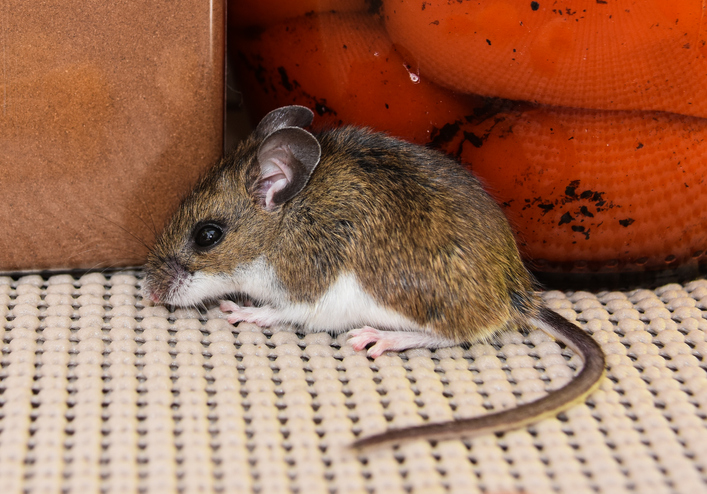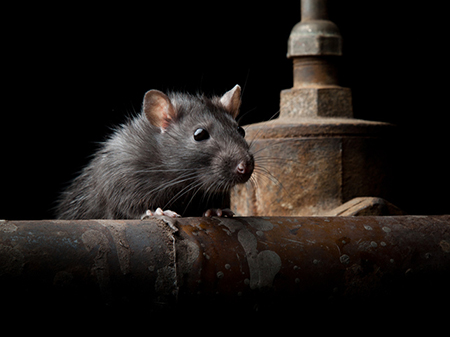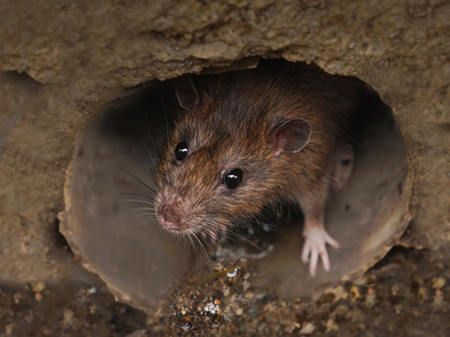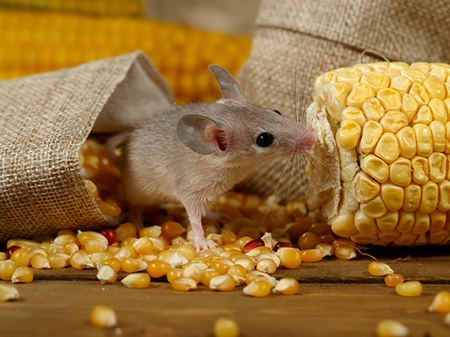
House Mice
As their name suggests, the house mouse is the most common species of mouse that is found invading homes. These mice can be identified by their small, slender bodies, long tails, large ears, and small dark beady eyes. They typically grow up 3 ¾ inches in length but when you include their tails in that measurement, their total length can reach almost 8 inches. Their tail and ears are both covered with a layer of soft velvety fur. Their fur can vary in color from grayish-brown to dark gray or black in color; they have a lighter colored belly that is usually tan or whitish in color.

Roof Rats
Roof rats are dark brown or black in color with some gray hairs sprinkled about; their underbellies are lighter in color. Roof rats can be identified by their pointed noses, large dark eyes, and large ears. They have long, thin bodies. Their slim build allows them to easily climb trees and gain access to the roofs of homes. The bodies of these rodents grow up 8 and their long scaly tails add another 6-8 inches to their total length.

Norway Rats
Norway rats have brown fur peppered with black hairs, lighter colored underbellies, and bi-colored tails. They have blunt noses, protruding small black eyes, and small ears. Adult Norway rats have long “heavy” bodies that grow up to 9 ½ inches in length; their tails add another 6 to 8 inches to their total body length. Larger than roof rats, they also lack the agility and climbing abilities that roof rats possess. Norway rats typically infest basements and lower levels of buildings.

White-Footed Mouse
The white-footed mouse is mainly associated with rural areas and is commonly found living in and around wooded areas; they are native to North America. They are small mice that grow between 6 and 7 ½ inches in length, including their tails. White-footed mice have large ears covered with tufts of hair, brown eyes, vary in color depending on the time of the year. They do have a distinctive dark line running down the middle of their backs. While you may find white-footed mice inside, they aren’t typically nesting inside but rather foraging for food.
More Facts About Rodents
Where do rodents nest?
Outside, roof rats nest trees, woodpiles, dense vegetation, and piles of debris. Inside they like to nest in the upper levels of buildings including attics and in ceilings. Norway rats, in contrast, are more likely to be found nesting in the basement of homes or behind the walls of the ground floor. Outside, Norway rats burrow and nest underneath of buildings, concrete slabs, in garbage dumps, and along the banks of streams, ponds, and lakes. As you can imagine, house mice are more often than not found nesting inside of homes behind walls, underneath flooring, behind appliances, in crawl spaces, and in the basement or attic. The white-footed mouse is more likely to be found nesting outside rather than inside of a home. They nest in hollow trees, under piles of debris, in abandoned bird’s nests, and inside barns and other outbuildings.
Why do I have a rodent problem?
If you’ve discovered rodents in your home or office, it’s likely they found a way in and their happy with food and water sources as well as the options for safe shelter. Outside, they may be attracted to open garbage cans or dumpsters, gardens, compost piles, fruit trees, bird feeders, and pet food. It is also said that rats love dog feces.
Are rodents dangerous?
Yes, rodents are considered to be dangerous. They constantly chew to keep their incisors at a reasonable length. Unfortunately, this means that electrical wires, lumber, insulation, drywall, and other building materials as well as personal belongings may be chewed on by these pests, creating significant damage. They also contaminate surfaces and items with their urine and droppings.
In addition to causing damages rodents can transmit a wide variety of diseases and bacteria to people. White-footed mice are carriers of Borrelia burgorferi, the bacteria that causes Lyme disease, these mice are typically the first blood meal for black-legged ticks, who then transmit the disease to people. Other diseases that rodents can spread include: Lymphocytic choriomeningitis (LCM), salmonellosis, dysentery, Hantavirus, and leptospirosis
How do I get rid of rodents?
In order to resolve a rodent problem, accurate identification is necessary. At Superior Pest Solutions, we’ve been getting rid of mice and rats from New Jersey homes and businesses since 1987, and have the training and experience to identify, control, and prevent rodent infestations. Visit our rodent control page to learn more about our methods for evicting these unwanted pests.
You might think that grabbing a couple of snap traps at the hardware store will take care of the problem or poison might do the trick but professional rat control and mouse control is highly recommended. Most property owners do not place traps in the appropriate areas and other DIY solutions can be dangerous or cause rodents to move into other areas of the house or building. If you’ve found mouse poop in a drawer, heard movement in your walls at night, or have had a face to face encounter with a rodent, our New Jersey pest control company is ready to help. Contact us today to learn more about our comprehensive rodent control services.
How do I prevent rodent infestations?
Rodents are difficult to prevent but correcting the conditions that attract them is a great start to rodent prevention. Take a look at the tips listed below for ways to keep mice and rats out.
- Seal openings that rodents could use as entry points. Remember mice can squeeze through the tiniest of gaps.
- Caulk gaps found around windows and doors.
- Seal spaces found around utility entrances and vents.
- Repair holes in the roof or on the sides of the structure. Also replace loose or missing shingles.
- Install tight-fitting caps on chimneys.
- Cover outdoor trash bins and keep areas around dumpsters clear of cardboard boxes and crates.
- Keep compost piles well away from the house and harvest gardens whenever possible.
- Pick up fruit that has dropped from trees.
- Fix leaking pipes and fixtures and unclog gutters.
- Eliminate clutter in attics, basements, garages, and other storage areas.
